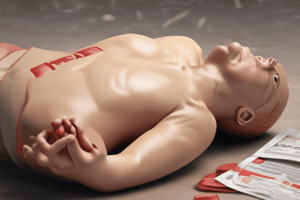Podcast
Questions and Answers
What is the primary purpose of the American Red Cross CPR/AED for Professional Rescuers program?
What is the primary purpose of the American Red Cross CPR/AED for Professional Rescuers program?
To train professional-level rescuers to respond to breathing and cardiac emergencies.
Which of the following are examples of bloodborne pathogens of primary concern to professional rescuers? (Select all that apply)
Which of the following are examples of bloodborne pathogens of primary concern to professional rescuers? (Select all that apply)
- Hepatitis B virus (correct)
- Influenza virus
- Human Immunodeficiency virus (HIV) (correct)
- Hepatitis C virus (correct)
Consent must always be obtained from a parent or guardian for an adult victim.
Consent must always be obtained from a parent or guardian for an adult victim.
False (B)
What is implied consent?
What is implied consent?
What should a rescuer do if a victim refuses care?
What should a rescuer do if a victim refuses care?
The hepatitis B vaccine is given in a series of _____ doses.
The hepatitis B vaccine is given in a series of _____ doses.
What is the risk associated with hepatitis C?
What is the risk associated with hepatitis C?
Legal considerations for professional rescuers include the duty to act and maintaining confidentiality.
Legal considerations for professional rescuers include the duty to act and maintaining confidentiality.
What is AIDS?
What is AIDS?
Which of the following conditions must be met for an infection to occur? (Select all that apply)
Which of the following conditions must be met for an infection to occur? (Select all that apply)
Bloodborne pathogens are spread by casual contact like hugging or shaking hands.
Bloodborne pathogens are spread by casual contact like hugging or shaking hands.
What is the highest risk of transmission of bloodborne pathogens?
What is the highest risk of transmission of bloodborne pathogens?
What viruses are primarily associated with bloodborne transmission?
What viruses are primarily associated with bloodborne transmission?
What are standard precautions intended to reduce?
What are standard precautions intended to reduce?
The most effective method to prevent the spread of infection is __________.
The most effective method to prevent the spread of infection is __________.
Employers are required by OSHA to protect employees from exposure to bloodborne pathogens.
Employers are required by OSHA to protect employees from exposure to bloodborne pathogens.
What should you do immediately if you are exposed to a bloodborne pathogen?
What should you do immediately if you are exposed to a bloodborne pathogen?
Which of the following actions is part of the post-exposure protocol?
Which of the following actions is part of the post-exposure protocol?
Which of the following conditions should prompt you to summon EMS personnel? (Select all that apply)
Which of the following conditions should prompt you to summon EMS personnel? (Select all that apply)
You should only move a victim if they are in immediate danger.
You should only move a victim if they are in immediate danger.
What does the mnemonic AVPU stand for?
What does the mnemonic AVPU stand for?
If an adult or child is unresponsive, you should first __________ the victim.
If an adult or child is unresponsive, you should first __________ the victim.
Which technique should be used to open the airway of a victim suspected of having a spinal injury?
Which technique should be used to open the airway of a victim suspected of having a spinal injury?
Match the following emergency moves with their appropriate conditions:
Match the following emergency moves with their appropriate conditions:
What should you do if a victim shows signs of severe life-threatening bleeding?
What should you do if a victim shows signs of severe life-threatening bleeding?
It is safe to assume a pulse is present if you cannot find one within 10 seconds.
It is safe to assume a pulse is present if you cannot find one within 10 seconds.
What is the appropriate action if a victim is unresponsive but breathing?
What is the appropriate action if a victim is unresponsive but breathing?
In a situation where you are alone and responding to someone who is unresponsive and you did not see them collapse, what should you do?
In a situation where you are alone and responding to someone who is unresponsive and you did not see them collapse, what should you do?
What is the definition of a child for the purpose of this course?
What is the definition of a child for the purpose of this course?
To prevent the transmission of infectious diseases, always take appropriate __________.
To prevent the transmission of infectious diseases, always take appropriate __________.
When moving an injured victim, what is one key safety practice you should remember?
When moving an injured victim, what is one key safety practice you should remember?
Flashcards are hidden until you start studying
Study Notes
Legal and Ethical Responsibilities of Professional Rescuers
- Professional rescuers have a job-related duty to act in emergencies, which can impact the survival of victims.
- Consent to treat can be verbal or implied, especially in cases involving minors or unresponsive individuals.
- Confidentiality is paramount; private information learned during care should only be shared with authorized medical personnel.
CPR/AED Training Overview
- The American Red Cross CPR/AED for Professional Rescuers program trains rescuers on addressing breathing and cardiac emergencies in various age groups.
- Training aligns with the 2015 International Liaison Committee on Resuscitation (ILCOR) and American Heart Association guidelines.
- Continuous updates in emergency care procedures are the responsibility of the rescuer.
Acknowledgments and Development
- The handbook honors the dedication of American Red Cross employees and volunteers who teach lifesaving skills globally.
- Contributions from various experts in emergency medicine and related fields have shaped the training content.
Structure of the Handbook
- Key sections include legal considerations, breathing emergencies, cardiac emergencies, and skill sheets detailing procedures and emergency moves.
- Emphasis on the importance of documenting care provided to establish a record of actions taken during emergencies.
Bloodborne Pathogen Awareness
- Understanding bloodborne pathogens and their transmission is critical for professional rescuers.
- Safety measures should be adopted to prevent exposure while providing care in emergency situations.
Skill Sheets and Equipment Usage
- The handbook includes practical skill sheets focused on key emergency skills such as:
- Removal of gloves
- Use of a resuscitation mask
- Procedures for CPR in one-rescuer and two-rescuer scenarios
- Operating Automated External Defibrillators (AEDs)
- Practice in moving victims safely during emergencies is also covered to ensure responders can act efficiently.
Importance of Continuous Learning
- Rescuers should stay informed about updates in emergency care practices to maintain effectiveness and compliance with current standards.
Emergency Care Principles
- Provide emergency care according to your training level to avoid negligence.
- Negligence is the failure to adhere to a standard of care, leading to injury or harm.
- Respect a competent victim’s refusal of care, which must be honored regardless of the situation.
- Document any refusal of care with a witness present to provide accountability.
- Avoid abandonment of care; continue until someone with equal or higher training takes over.
- Maintain confidentiality regarding information learned during care.
Infection Prevention
- Protect yourself and others from infectious diseases during care.
- Bloodborne pathogens (bacteria and viruses) can lead to significant health issues.
- Common bloodborne pathogens include Hepatitis B, Hepatitis C, and HIV.
- Bacteria can survive outside the body and are often treatable with antibiotics.
- Viruses require living organisms to survive and are harder to eliminate.
Bloodborne Pathogens Overview
-
Hepatitis B:
- Symptoms: Fatigue, abdominal pain, jaundice.
- Transmission: Direct and indirect contact via blood, saliva, and other fluids.
- Prevention: Vaccination available, mandatory for at-risk workers.
-
Hepatitis C:
- Symptoms: Similar to Hepatitis B, including fatigue and jaundice.
- Treatment: No vaccine available; most common chronic bloodborne infection in the U.S.
-
HIV:
- Symptoms may not appear initially, leading to delayed diagnosis.
- Affects the immune system and can result in AIDS.
- Risk increased with direct exposure to blood and bodily fluids.
Understanding Disease Transmission
- Four conditions must be met for pathogen transmission to occur:
- Presence of a pathogen.
- Sufficient quantity of the pathogen.
- Susceptibility of the individual.
- Portal of entry for the pathogen.
Modes of Transmission
- Direct Contact: Infection spread through direct exposure to infectious materials.
- Indirect Contact: Occurs when touching contaminated surfaces or objects.
- Droplet Transmission: Inhaling droplets from a cough or sneeze of an infected individual.
- Vector-Borne Transmission: Spread of pathogens through bites from infected insects or animals.
Risk Assessment
- Hepatitis B has a high transmission risk after needlestick exposure.
- Hepatitis C infection risk is lower than Hepatitis B, but more serious in consequences.
- HIV has the lowest transmission risk due to needlestick exposure.
Regulatory Compliance
- OSHA has established regulations to manage occupational exposure to bloodborne pathogens.
- Employers must minimize risk through safe practices and disposal methods.
- Employees, especially those providing emergency care, are required to follow these safety protocols.### Employers' Responsibilities
- OSHA mandates employers to protect employees from bloodborne pathogens.
- Identification of positions at risk of exposure to contaminated sharps is necessary.
- An exposure control plan must be created to minimize the risk of exposure incidents.
- A cleaning and decontamination schedule for the workplace is essential.
- Employers should maintain a sharps injury log that includes device type, location, and descriptions of incidents for recordkeeping.
- Employees should have access to free hepatitis B vaccinations.
- Procedures must be established for reporting exposure incidents while ensuring medical confidentiality.
Exposure Control Plan
- Must outline protective measures to minimize exposure and describe response protocols for exposure incidents.
- Should be available to all personnel potentially in contact with infectious materials.
Standard Precautions
- Combines universal precautions and body substance isolation, treating all body fluids as potentially infectious.
- Implement through the use of personal protective equipment (PPE), good hand hygiene, engineering controls, work practice controls, proper equipment cleaning, and spill clean-up procedures.
Personal Protective Equipment (PPE)
- PPE must be specified in the exposure control plan and include items like gloves, gowns, masks, and protective eyewear.
- Guidelines for usage include avoiding direct contact with potentially infectious materials and using barriers during ventilation assistance.
Hand Hygiene
- Handwashing is vital before and after patient care to prevent the spread of infection.
- Use soap and water or alcohol-based sanitizers when washing hands is not possible.
Engineering and Work Practice Controls
- Engineering controls include using biohazard containers for sharps and safer medical devices.
- Work practice controls focus on changes in procedures to reduce exposure risk, such as proper disposal methods and immediate spill responses.
Equipment Cleaning and Spill Clean-Up
- Equipment must be cleaned and disinfected after use, with soiled items placed in labeled containers.
- Use appropriate PPE during clean-up, and isolate contaminated areas.
- For blood spills, a bleach solution is recommended for disinfection.
Post-Exposure Actions
- Immediate cleaning of the exposed area with soap and water is crucial.
- Report incidents to supervisors and document details surrounding the exposure, including actions taken post-exposure.
- Follow-up care should be sought as per the facility’s exposure control plan.
Emergency Response Protocols
- Size up the scene for safety, considering the well-being of both the victim and rescuers.
- Conduct a primary assessment and determine the need for emergency medical services (EMS).
- Provide care based on assessment findings while ensuring to obtain consent from responsive victims.
Studying That Suits You
Use AI to generate personalized quizzes and flashcards to suit your learning preferences.




